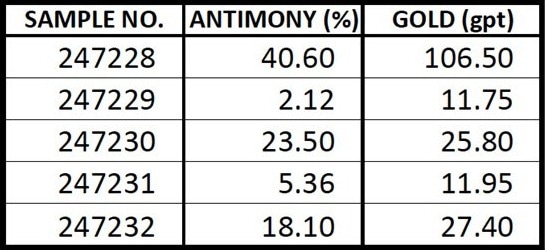Military Metals Corp. ("MILI") reports the analyses of five samples of antimony (stibnite) and gold-rich mineralized material taken from a historical mine stockpile at the Company's 100% owned past producing West Gore antimony-gold project ("West Gore") located in the Province of Nova Scotia, Canada. These samples were collected as part of efforts to characterize the historical deposit to optimize initial exploration methods. These high-grade results support the documented grades of material historically mined between 1914-1917 when West Gore was one of Canada's most significant antimony producers during World War One, to support the allied war effort. These results complement the announcement on July 8, 2025 that the Company had identified new drill targets extending well beyond the area of previous mining, plans to commence a drill program are currently being finalized.
 Sample 247228 Demonstrating Massive Stibnite. Image Credit: Military Metals Corp
Sample 247228 Demonstrating Massive Stibnite. Image Credit: Military Metals Corp
Historical Stockpile Sample Highlights:
- Highest grade sample returned 40.6 percent (%) Antimony and 106.5 Grams Per Tonne (gpt) in sample 247228 (Antimony samples ranged from 2.12% to 40.6%, gold samples ranged from 11.75 gpt to 106.5 gpt
- Additional high-grade antimony results included 23.5% and 18.1% in samples 247230 and 247232, respectively
- Additional high-grade gold results included 27.4 gpt and 25.8 gpt in samples 247232 and 247230, respectively
- Average antimony results over all five samples of 17.94%
- Average gold results over all five samples of 34.68 gpt
- 3 high priority drill targets that were never previously identified will be drill tested in an upcoming work program
Scott Eldridge, CEO of Military Metals, stated: "The recent samples collected of up to 40.6% antimony seen in massive stibnite, the mineral that hosts antimony, from our project area have returned some spectacular results, reinforcing our exploration plan to commence drilling. With additional exploration, we can further unlock the potential of our asset and, play a strategic role in the critical minerals supply chain at a time when secure, domestic sources of antimony are in growing demand. Today's results also demonstrate the gold values that could be an important by-product or co-product as we prepare to drill. We are extremely encouraged by the high antimony and gold grades of these five specimens from the past producing mine at our Nova Scotia project. We look forward to advancing this discovery through further exploration and unlocking its full value for our shareholders. Nova Scotia's government, led by Environment Minister Tim Halman, has announced updates to the approval process for metal-mining projects aimed at accelerating timelines. In summary, the new rules are designed to streamline mining approvals and benefit industry progress."
Summary of Results:
Historical documentation reports that 32,000 metric tons were mined at West Gore in turn producing 7,000 metric tons of concentrate grading 46% antimony yielding 3,220 metric tons of antimony metal, and 6,861 ounces of gold (source: NI 43-101 Technical Report for the West Gore Sb-Au Project, May 25, 2021, prepared by M.S. King, PGeo & M.C. Corey PGeo, May 25, 2021, for Battery Elements Corp). This indicates recovered grades of 10.06% antimony and 0.21 ounces per ton (6.5 gpt) gold, historically. Historical mining was both small-scale and selective, almost certainly enhanced by hand sorting at surface prior to processing. Commercial production ceased in 1917.
Table 1 below displays the analytical results for antimony and gold from the five samples. Antimony varies from a low of 2.12 to a high of 40.6%, for an average of 17.94%; gold varies from a low of 11.75 to a high of 106.5 gpt, for an average of 34.68 gpt (uncapped). These grades support the accuracy of historical documentation of mined grades. Of mineralogical interest is the fact that two of the samples, 247230 and 247231, ran 2.01 and 2.81% lead, respectively.
Table 1. Sample Results. Source: Military Metals Corp

Quality Assurance and Quality Control:
The samples were analyzed at the laboratories of ALS Canada in Vancouver. Samples were crushed, split, ground, split, and a 35 gram portion subjected to a four-acid digestion followed by Induction Coupled Plasma ("ICP") - Mass Spectrometry ("MS") analysis. Over-limit samples for gold and antimony (all five of them) were analyzed by fire assay and ICP- Atomic Emission Spectrometry ("AES") analysis, respectively. Internal Quality Assurance - Quality Control protocols were followed by the lab including blanks, standards, and duplicates to ensure analytical accuracy.
Mining History and Geology of the Region:
Gold in Nova Scotia was first discovered in 1860, which led to gold rushes throughout many parts of the province over the years following. Gold production in the Rawdon hills began in 1884 and continued until 1932 from several mines. Gold deposits of Nova Scotia's Meguma Terrane typically occur as relatively shallow-dipping, bedding-parallel "saddle reef" type vein systems controlled by regional fold structures. Gold deposits of the Rawdon area, which is found at the east edge of West Gore, are uniquely characterized by the occurrence of steeply east-dipping gold-bearing veins striking north-northwest across bedding. The Government of Nova Scotia's Mineral Occurrence Database reports that historical production from the Rawdon Hills area mines totaled 13,494 ounces. Antimony is a common accessory element in many gold mines around the world, occasionally occurring in higher concentrations.
The technical contents of this release were reviewed and approved by David Murray PGeo, President and Principal Consultant of Resourceful Geoscience Solutions Inc. of Halifax, Nova Scotia, a consultant to the Company, and qualified person as defined by National Instrument 43-101. Mr. Murray has independently verified that the historical information presented here about the West Gore deposit is consistent with the historical records available.